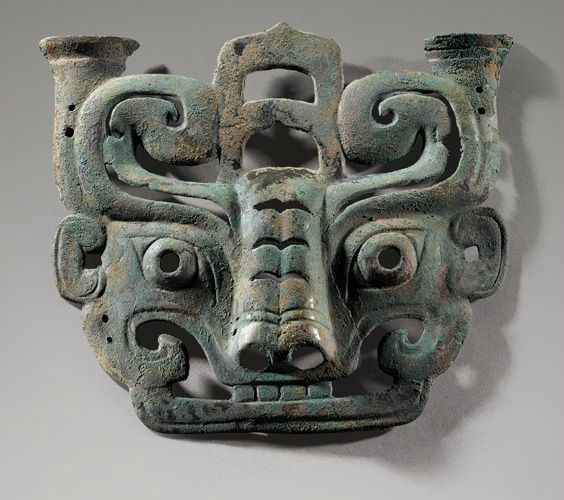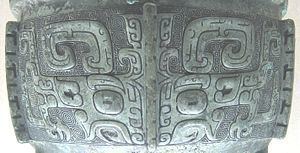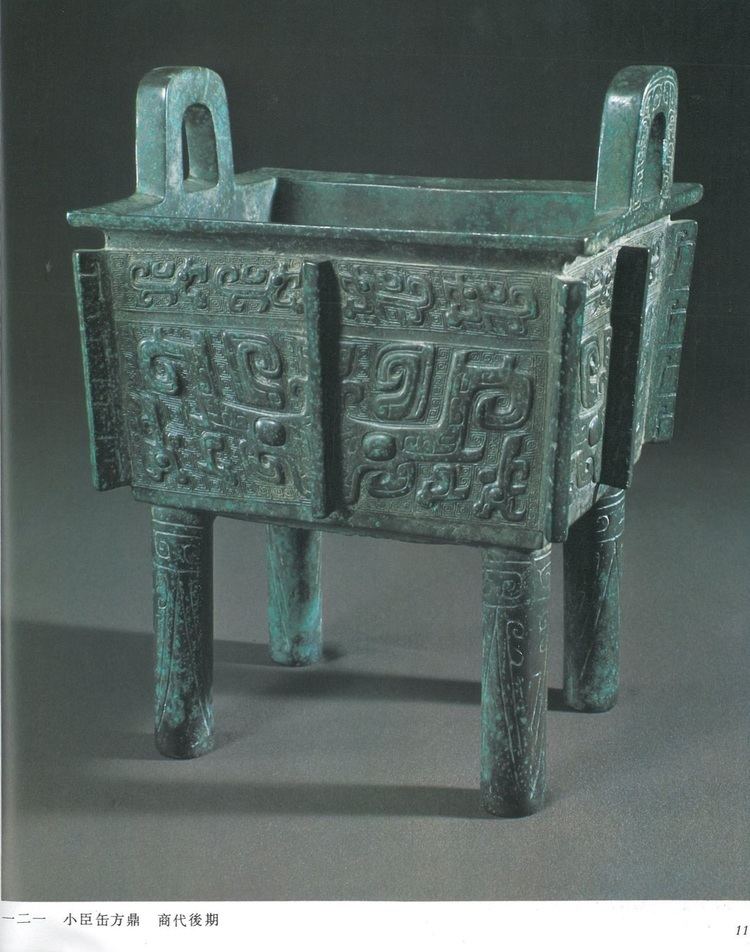Chinese 饕餮 Hanyu Pinyin IPA [tʰáutʰjê] | Literal meaning gluttonous ogre Wade–Giles tao t'ieh Middle Chinese *tʰɑu.tʰˁət | |
 | ||
Similar Eight Immortals, Chi (mythology), Nine sons of the dragon | ||
Cultural studies the taotie image in chinese art culture and cosmology
The taotie is both one of the four evil fiends in Chinese mythology and a motif commonly found on Chinese ritual bronze vessels from the Shang and Zhou dynasty. The design typically consists of a zoomorphic mask, described as being frontal, bilaterally symmetrical, with a pair of raised eyes and typically no lower jaw area. Some argue that the design can be traced back to jade pieces found in Neolithic sites such as the Liangzhu culture (3310–2250 BCE).
Contents
- Cultural studies the taotie image in chinese art culture and cosmology
- Taotie
- Design
- Etymology
- Later interpretations
- In popular culture
- References

In ancient Chinese mythology like "Classic of Mountains and Seas", taotie (饕餮) is one of the "four evil creatures of the world" or four fiends along with Hundun (渾沌), Qiongqi (窮奇)and Taowu (梼杌). On the opposite side, there are four holy creatures in Chinese mythology which called Azure Dragon, Vermilion Bird, White Tiger and Xuanwu.

Taotie
Design

Scholars have long been perplexed over the meaning (if any) of this theriomorphic design, and there is still no commonly held single answer. The hypotheses range from Robert Bagley's belief that the design is a result of the casting process, and rather than having an iconographic meaning was the artistic expression of the artists who held the technological know-how to cast bronze, to theories that it depicts ancient face masks that may have once been worn by either shamans or the god-kings who were the link between humankind and their deceased ancestors (Jordan Paper).

The once-popular belief that the faces depicted the animals used in the sacrificial ceremonies has now more or less been rejected. (Although some faces appear to be oxen, tigers, dragons, etc. some argue that the faces are not meant to depict actual animals, feline or bovine.) Most scholars favor an interpretation that supports the idea that the faces have meaning in a religious or ceremonial context, as the objects they appear on are almost always associated with such events or roles. As one scholar writes "art styles always carry some social references." It is interesting that even Shang divination inscriptions shed no light on the meaning of the taotie.
Etymology

It is not known what word the Shang and Zhou used to call the design on their bronze vessels; as Sarah Allan notes, there is no particular reason to assume that the term taotie was known during the Shang. In fact, the first known occurrence of this word is in Zuo Zhuan, where it is used to refer to one of the four evil creatures of the world Chinese: 四凶; pinyin: sì xiōng: a greedy and gluttonous son of the Jinyun clan, who lived during the time of the legendary Yellow Emperor. The word taotie itself was glossed by a Zuo Zhuan commentator as "glutton".
Nonetheless, the association of the term taotie with the motif on the Zhou (and Shang) bronzes is sufficiently ancient. It comes from the following passage in the Lu’s Spring and Autumn Annals (16/3a, "Prophecy"):

The taotie on Zhou bronzes [ding] has a head but no body. When it eats people, it does not swallow them, but harms them.
(In another translation, given in Allan 1991, p. 145, the second sentence is translated as follows: "It devoured a man, but before it could swallow it, its own body was damaged".) In Sarah Allan's view, association between gluttony (the meaning in Zuo Zhuan) and the dings' use for food sacrifices to the "insatiable" spirits of the dead is significant.
Li Zehou comments on the description of the taotie in the Spring and Autumn Annals as follows:

It is hard to explain what is implied in this, as so many myths concerning the taotie have been lost, but the indication that it eats people accords fully with its cruel, fearful countenance. To alien clans and tribes, it symbolized fear and force; to its own clan or tribe, it was a symbol of protection. This religious concept, this dual nature, was crystallized in its strange, hideous features. What appears so savage today had a historical, rational quality in its time. It is for precisely this reason that the savage old myths and legends, the tales of barbarism, and the crude, fierce, and terrifying works of art of ancient clans possessed a remarkable aesthetic appeal. As it was with Homer’s epic poems and African masks, so it was with the taotie, in whose hideous features was concentrated a deep-seated historic force. It is because of this irresistible historic force that the mystery and terror of the taotie became the beautiful—the exalted.

Li Zehou further notes, "Some scholars consider that the meaning of 'taotie is not "eating people" but making a mysterious communication between people and Heaven (gods)."
Later interpretations
During the Ming dynasty, a number of scholars compiled lists of traditional motifs seen in architecture and applied art, which eventually became codified as the Nine Children of the Dragon (龍生九子). In the earliest known list of this type (in which the creatures are not yet called "children of the dragon", and there are 14 of them, rather than 9), given by Lu Rong (1436–1494) in his Miscellaneous records from the bean garden (菽园杂记, Shuyuan Zaji), the taotie appears with a rather unlikely description, as a creature that likes water and depicted on bridges. However, a well-known later list of the Nine Children of the Dragon given by Yang Shen (1488–1559) accords with both the ancient and the modern usage of the term:
The taotie likes to eat and drink; it used to appear on the surface of the dings.
Some scholars believed that the Taotie motif is a reference to Chi You and is used to serve as a warning to people who covet power and wealth. According to notes by the Qing dynasty painter Luo Ping/Luo Pin:

Huang Di ordered his men to have Chi You beheaded... seeing that Chi You's head was separated from his body, later sages had his image engraved on sacrificial vessels as a warning to those that would covet power and wealth.
In the Book of Imaginary Beings (1957) Jorge Luis Borges interpreted the figures as representing a dog-headed, double-bodied monster that represented greed and gluttony.
In popular culture
The Tao Tei are the primary antagonists in the 2017 historical-fantasy epic film The Great Wall.
